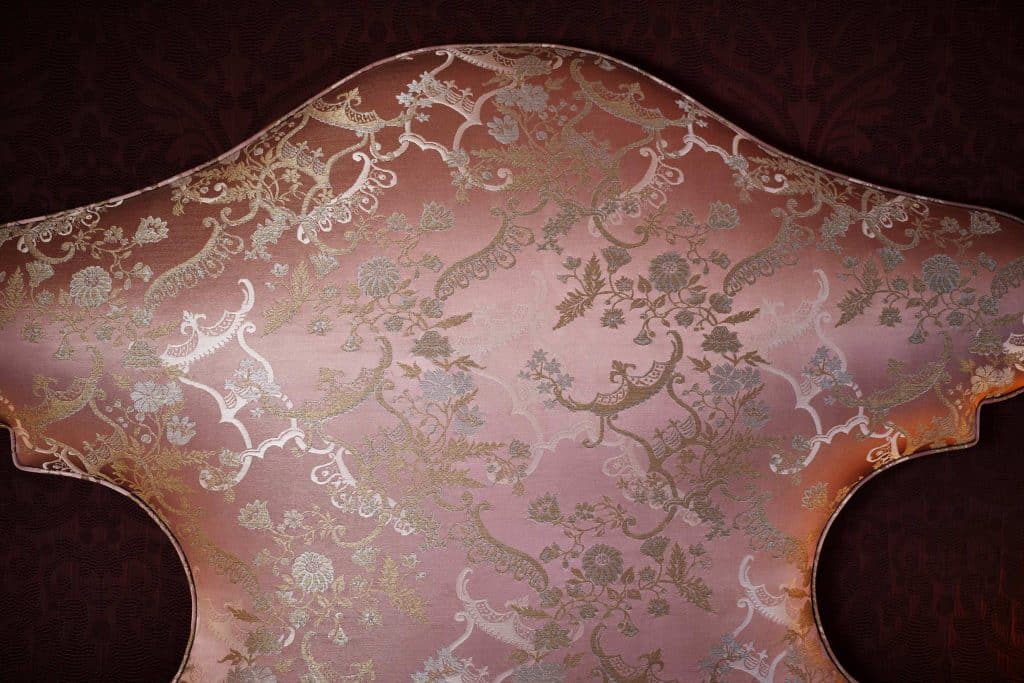
CHINESE INSPIRATION
As early as the 16th century, Europe embraced a taste for Chinese decorative styles. Dubbed “chinoiserie” in the following century, this inspiration adorned fabrics and wallpapers with motifs of pagodas, gardens, and exotic birds, all interpreted in a distinctly European manner.
You’ll find this inspiration in the Luce, Céleste, Hortense, and Marguerite rooms and suites.
Luce
CHINESE INSPIRATION
Previous slide
Next slide
With her long, bouncing red hair cascading over her milky shoulders, her sparkling black eyes, her curvaceous body, and mischievous smile, Luce is as carefree as a summer morning. Her ethos is carelessness, to avoid opening the door to melancholy. Cultivating a zest for life, she generously offers her heart and her bed, delighting in ensnaring men who hardly resist her charm. Although she may sometimes have a weakness for handsome boys, especially the dashing cavalry officers, she never forgets that, in her line of work, before looking at a man’s face, it’s wise to inspect his wallet…
Like the famous courtesan Ninon de Lenclos of the previous century, she categorizes her lovers into three types: the payers, the martyrs, and the favorites. Of her liaisons, she says: “Three months is infinity”…
Céleste
CHINESE INSPIRATION
Previous slide
Next slide
Celeste Vénard’s life is a true novel. A child of the street, a prostitute at fifteen, this “valiant heart,” as Alexandre Dumas would later write, has only one desire: to flee the precariousness of her childhood. Gifted with impressive willpower and a certain charm, she meets both the artistic and literary bohemians of the time and powerful politicians, from Prince Napoleon to Gambetta, who help her climb the social ladder: soon adored as an actress, dancer, singer, and theater director, “La Mogador” -her stage name- joins the select circle of the most sought-after courtesans in Paris.
In 1853, her marriage to a count and her life in Australia transformed her into a woman of society. Financial ruin and widowhood later, the woman who had become the Countess of Chabrillan returned to Paris and took charge of theaters. The former mistress of politicians who tried in vain to prevent the tragedy of the Commune and inspired numerous writers was, in Dumas’ words, the “most generous valiant heart” of her time.
In 1853, her marriage to a count and her life in Australia transformed her into a woman of society. Financial ruin and widowhood later, the woman who had become the Countess of Chabrillan returned to Paris and took charge of theaters. The former mistress of politicians who tried in vain to prevent the tragedy of the Commune and inspired numerous writers was, in Dumas’ words, the “most generous valiant heart” of her time.
Hortense
CHINESE INSPIRATION
Previous slide
Next slide
Her name is Hortense Schneider and her name is linked to the famous operetta composer, Jacques Offenbach. She has a conquering smile, mischievous eyes, a pretty voice, a passion for the stage, and a gift of the gab that nothing undermines. She loves the theater so much that she easily outshines those who use it only as a stepping stone and who turn out to be more courtesans than actresses. Recruited by the famous musician at the Bouffes-Parisiens, she achieves triumph: she is launched. Hortense dines at Café Anglais, a famous restaurant that has the advantage of offering its clientele private rooms, moves in a luxurious carriage, and indulges in a liaison with a young lion of the boulevard, the Duke of Gramont-Caderousse.
En 1864, her triumph in the role of La Belle Hélène earned her European fame. Everything about her, her words, gestures, and habits, were observed and reported: Hortense symbolized unbridled pleasure and wild verve that characterized the imperial festivities. Napoleon III, Alexander II, Grand Duke Constantine, the Prince of Wales, the Prince of Orange, the King of Portugal – all courted the dazzling empress of operetta whom a jealous rival had nicknamed: “The Passage of Princes!”
Marguerite
CHINESE INSPIRATION
Previous slide
Next slide
Marguerite Alibert, 24 years old, had a regal bearing and remarkably fine features. In the early 20th century, during a leave in Paris, the young officer Edward, Prince of Wales and eldest son of George V, fell in love with this courtesan he met within aristocratic circles. Their romance lasted for eighteen months of champagne-filled parties, luxury carriage rides across the capital, and letters where Edward, amidst impassioned declarations, confided his troubles with his father. When the future king ended their relationship due to a new mistress, he demanded Marguerite to destroy those letters, which she wisely chose not to do.
Despite a tumultuous life, the former courtesan never uttered a word about her royal liaison nor exhibited those youthful letters. It’s easy to imagine that a secret arrangement was undoubtedly reached between the beautiful Marguerite and Edward VIII’s entourage…

